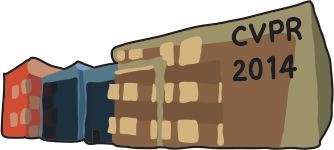-
Active Annotation Translation
AbstractWe introduce a general framework for quickly annotating an image dataset when previous annotations exist. The new annotations (e.g. part locations) may be quite different from the old annotations (e.g. segmentations). Human annotators may be thought of as helping translate the old annotations into the new ones. As annotators label images, our algorithm incrementally learns a translator from source to target labels as well as a computer-vision-based structured predictor. These two components are combined to form an improved prediction system which accelerates the annotators' work through a smart GUI. We show how the method can be applied to translate between a wide variety of annotation types, including bounding boxes, segmentations, 2D and 3D part-based systems, and class and attribute labels. The proposed system will be a useful tool toward exploring new types of representations beyond simple bounding boxes, object segmentations, and class labels, and toward finding new ways to exploit existing large datasets with traditional types of annotations like SUN, Image Net, and Pascal VOC. Experiments on the CUB-200-2011 and H3D datasets demonstrate 1) our method accelerates collection of part annotations by a factor of 3-20 compared to manual labeling, 2) our system can be used effectively in a scheme where definitions of part, attribute, or action vocabularies are evolved interactively without relabeling the entire dataset, and 3) toward collecting pose annotations, segmentations are more useful than bounding boxes, and part-level annotations are more effective than segmentations.
Related Material
[pdf][bibtex]@InProceedings{Branson_2014_CVPR,
author = {Branson, Steve and Eldjarn Hjorleifsson, Kristjan and Perona, Pietro},
title = {Active Annotation Translation},
booktitle = {Proceedings of the IEEE Conference on Computer Vision and Pattern Recognition (CVPR)},
month = {June},
year = {2014}
}
These CVPR 2014 papers are the Open Access versions, provided by the Computer Vision Foundation.
Except for the watermark, they are identical to the accepted versions; the final published version of the proceedings is available on IEEE Xplore.
Except for the watermark, they are identical to the accepted versions; the final published version of the proceedings is available on IEEE Xplore.
This material is presented to ensure timely dissemination of scholarly and technical work.
Copyright and all rights therein are retained by authors or by other copyright holders.
All persons copying this information are expected to adhere to the terms and constraints invoked by each author's copyright.

